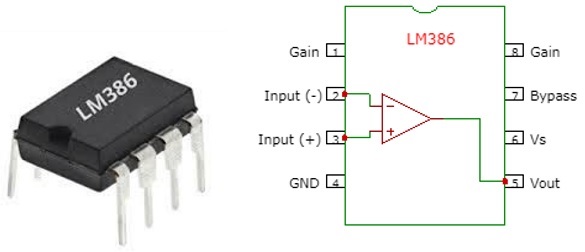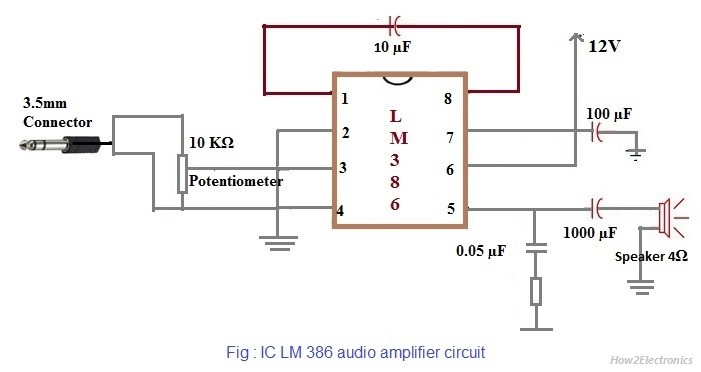AED 5.25
Description
The LM386 integrated chip is a low-power audio frequency amplifier that requires a low-level power supply (most often batteries). It is packaged in an 8-pin mini-DIP. The IC is intended to provide a voltage amplification of 20 without the use of any external components. However, by adding other components, this voltage gain can be increased to 200 (Vu = 200).
Package Includes:
- 1 x LM386N Audio Power Amp DIP IC
Features:
- Input is referenced by ground
- Self-concentric output static voltage
- Minimum external components
- Battery operation
- packaged in an 8-pin mini-DIP
- amplification of 20 Times without any external components
Description:
The LM386 integrated circuit is a low-voltage consumer audio power amplifier integrated circuit. It's appropriate for battery-powered gadgets including radios, doorbells, phones, guitar amplifiers, and hobby electrical projects. It is typically found in computer speakers and small portable stereos as an amplifier. The voltage gain of the amplifier can be adjusted to 20 and increased to 200 by adding additional components such as a resistor and a capacitor between pins 1 and 8. The LM386 IC amplifier has 8 pins, with pins 1 and 8 serving as gain control pins. This enables volume control; with a 9-volt power source, an amplifier can give output power ranging from 0.25W to 1W.
Principle of Work:
Three functional blocks make up the audio amplifier LM 386: power and output, bypass, and gain control.
Gain control is a feature that can be applied externally to IC pins #1 and #8.
Gain is the term used to describe a device's ability to amplify a low-signal audio input up to a certain level or capacity.
The inbuilt 1.35K resistor sets the gain of the IC to 20 when the aforementioned pinouts are left unconnected to anything.
The gain is suddenly raised to 200 if a capacitor is connected across the pinouts mentioned above. By simply connecting a pot in series with the capacitor previously described across pins 1 and 8, it is possible to easily alter the gain.
Pinout of the IC:

| Pin No | Pin Name | Description |
|---|---|---|
| 1 | GAIN | Gain Pin |
| 2 | INV-IN | Inverting Input Pin |
| 3 | NON-INV-IN | Non-Inverting Input Pin |
| 4 | GND | Ground Pin |
| 5 | Vout | Output Voltage Pin |
| 6 | Vs | Supply Voltage Pin |
| 7 | BYPASS | Bypass Pin |
| 8 | Gain | Gain Pin |
Applications:
- AM-FM radio amplifiers
- Portable tape player amplifiers
- Intercoms
- TV sound systems
- Line drivers
- Ultrasonic drivers
- Small servo drivers
- Power converter
Circuit:

This is how our microphone module and ESP32 will be connected. Please be aware that your ESP32's pinout may differ from the one shown here; to connect your module, use the GPIO numbers rather than the physical pins.
The LM386 IC, power supply of 12V, capacitors of 100 F, 1000 F, 0.05 F, and 10 F, potentiometer of 10 K, connection, a resistor of 10 K, and speaker of 4 F are the main parts of the audio amplifier. In accordance with the circuit schematic above, these parts are linked.
In order to understand the design of this audio amplifier, pins 4 and 6 of the power supply are first linked, with pin 4 being connected to the ground and pin 6 is connected to a 12V supply. A 3.5 mm connector is used to connect input from any type of audio sources, such as a cell phone or microphone, after the power supply. The right and left audio are connected by the LM 386 IC utilizing the source and ground terminals.
To manage the input level in the circuit, a potentiometer is connected to the input. In order to eliminate the DC components, a capacitor can also be connected in series to the input.
This IC's gain is set to 20, and it may be increased to 200 by inserting a 10 F capacitor between pins 1 and 8.
By attaching a capacitor (100 F) to pin 7 of the LM 386 IC, we may create a bypass capacitor to lower the noise.
A capacitor (0.05 F) and a resistor (10 ) are connected in series with the GND, which is linked to pin 5 of the IC, at the output connection. In order to change the input impedance, this circuit creates a Zobel network, a filter circuit with a capacitor and resistor.
The speaker can be connected anywhere between 4 and 32 ohms using impedance. A speaker (4 ) is utilized in this audio amplifier circuit. To eliminate the extraneous DC components from the signal, this speaker can be connected to a capacitor (1000 F).
Library:
No code is needed for this IC to function
Code:
No code is needed for this IC to function
Technical Details:
- Supply Voltage: 4V to Max. 15V (Typical)
- Voltage gain from 20 to 200
- Low static power drain: 4mA
- Low Distortion:0.2%
- Speaker impedance 4Ω
- Input Voltage: +/- 0.4 volts
- Storage Temperature: -65 degrees to +150degrees Celsius
- Operating Temperature: 0 to 70 degrees Celsius
- Power Output: 1.25 watts
Resources:
Comparisons:
The LM386-based amplifier is a well-known amplifier chip. The LM386, on the other hand, is not without flaws and restrictions. one issue with the LM386 is its high input impedance, which makes the chip susceptible to oscillations if the inputs are not appropriately isolated from the output. Its voltage gain of 20 (or 200 by inserting an extra capacitor) appears to be quite excessive for the line input level (1 V RMS), leading to additional oscillation difficulties. The LM4862 IC, on the other hand, is more advanced and slightly more powerful than the LM386, and it operates without the use of an electrolytic capacitor. and to compare the lm741 and the lm386 In addition, the input voltage for the 741 must be close to half that of the DC supply voltage. The inputs of the LM386 operate at its negative supply voltage, which is typically 0V. (ground). The 741 can drive a load of 2000 ohms thanks to its maximum output current of roughly 20 mA. The LM386 can operate an 8-ohm speaker because its maximum output current is around 810 mA. Negative feedback resistors must be added to the 741. There are resistors for negative feedback incorporated into the LM386. Above 9 kHz, the 741 has problems. To 300kHz, the LM386 performs nicely.